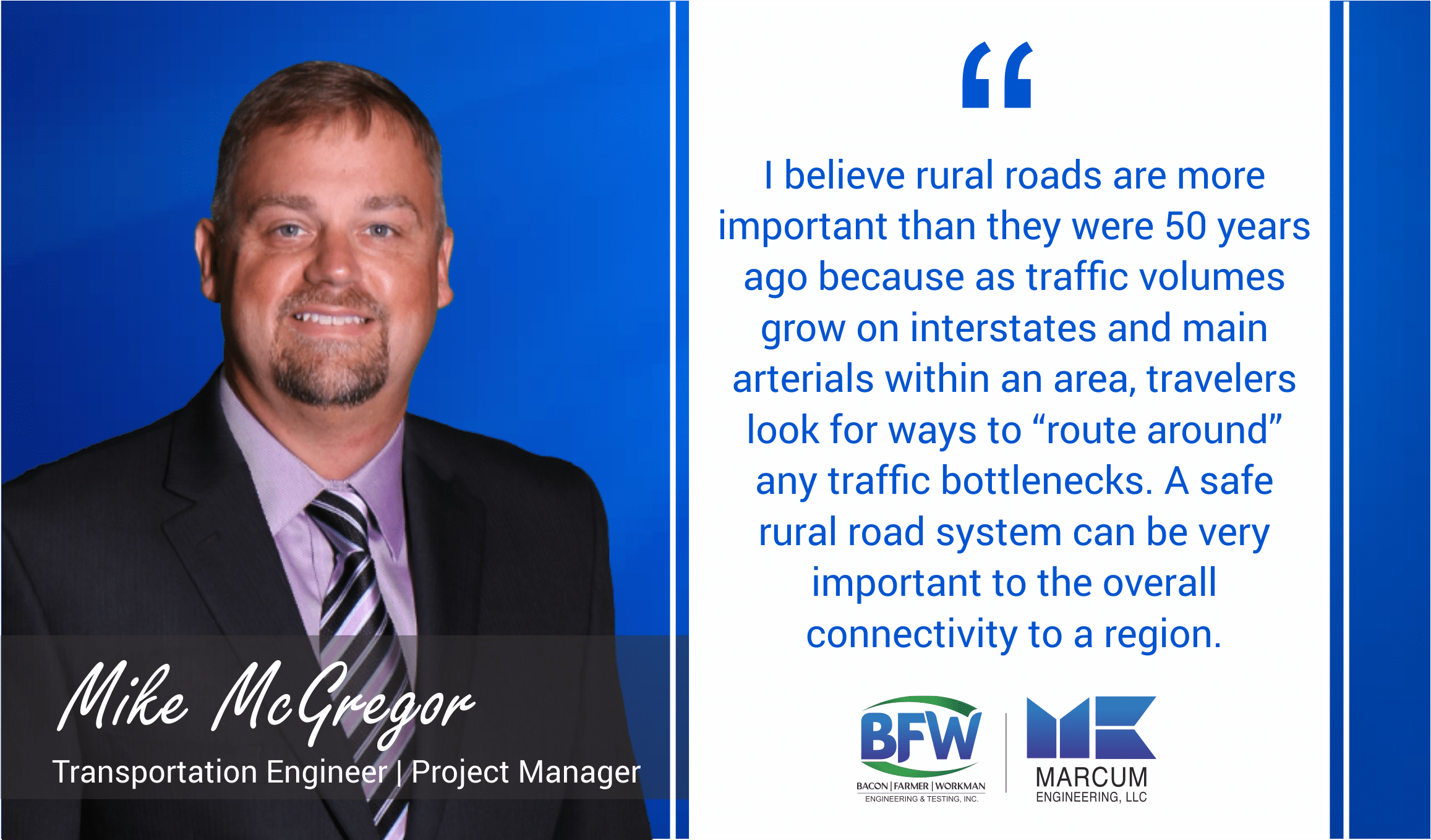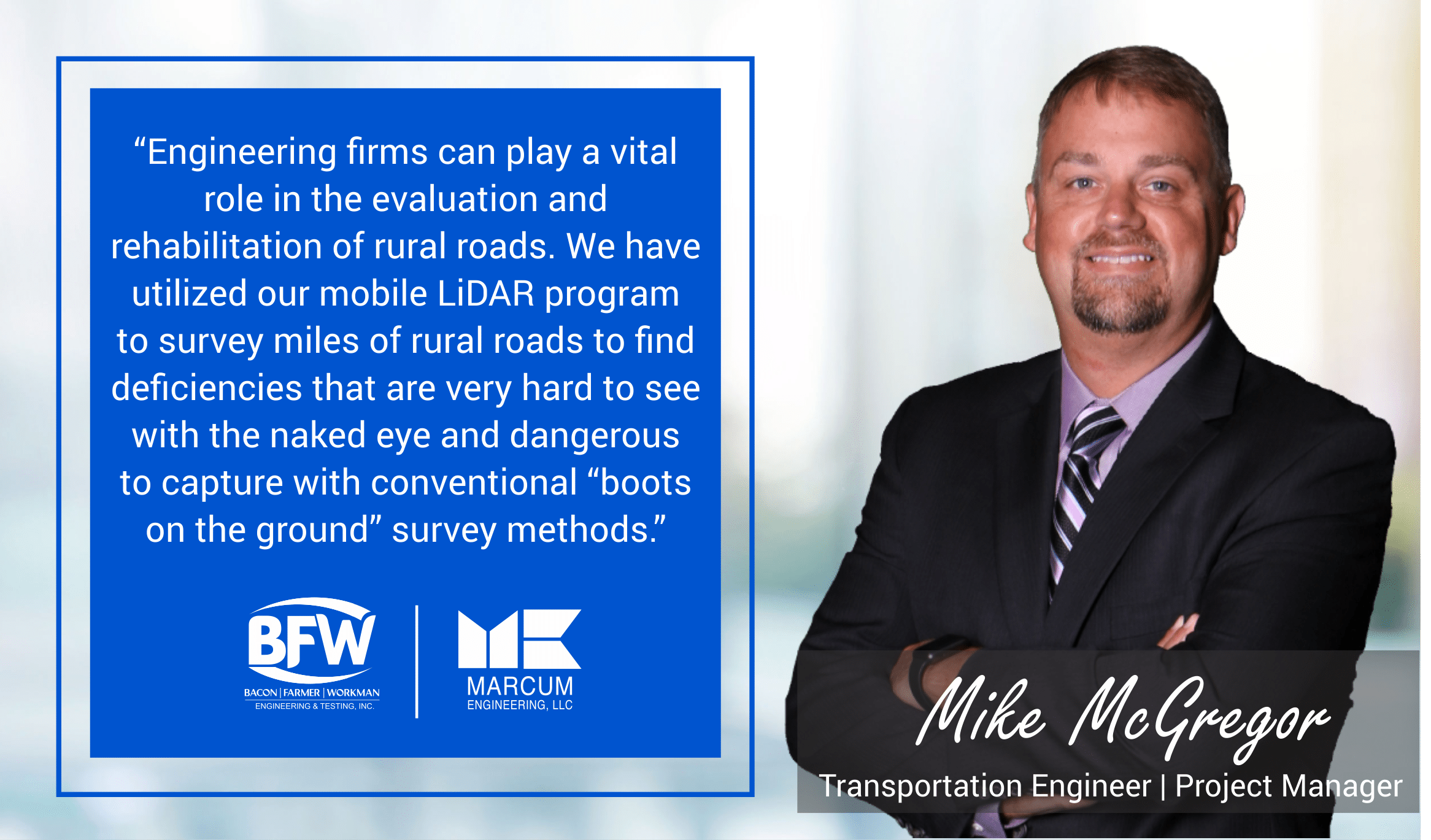From Point A to Point B: The Importance of Rural Roadways
The truth is, many of the country roads we drive on weren’t put there arbitrarily. They share a long history and one primary thing in common; they get you from point A to point B.
The Dawn of Rural Transportation
We asked Mike McGregor, Transportation Engineer/Project Manager, for his thoughts on rural roadway design. He explained that its genesis comes from a historical precedent that was set long ago.
“I would say that once people arrived in any given rural area, then that is when rural transportation began. Most roads began as a path that people took to go from one place to another. Maybe it was because it was the shortest distance, or maybe it was because it was the only way to overcome a physical obstacle (water, mountain, etc.).
As methods changed to get from point A to point B, the paths got wider and more defined: horse paths gave way to wagon roads, which then broadened into avenues that accommodated the first automobile and finally trucks. People needed ways to get over obstacles so they learned how to build bridges. The need for accomplishing a task always drives innovation and solutions. This is a truth that certainly applies to the evolution of rural transportation.”
To put it simply, necessity is the mother of invention. Any engineer can tell you that philosophy drives much of our work. We do things because they need to be done and rural transportation engineering is a perfect example.
Rural Roadways Drive Regional Connectivity
It’s true that the invention of the interstate in the 1950s initially reduced the original allure of the rural highway. Suddenly, America was gifted with wide, multi-lane roads that were flat, straight, and got them from state-to-state in record time.

“I believe rural roads are more important than they were 50 years ago because as traffic volumes grow on interstates and main arterials within an area, travelers look for ways to “route around” any traffic bottlenecks. Thus, more often, the cars that are on rural roads are less familiar with those roadways and they are typically driving faster than locals. A safe rural road system can be very important to the overall connectivity to a region.”
We agree with Mike. As rural transportation becomes more and more at the forefront, the need to make those roadways as safe as possible is all the more important.
Our Goal is to Make Your Drive as Safe as Possible
One thing we aim to improve as a firm that is firmly rooted in transportation engineering is rural roadway shoulder safety. Mike, with his extensive experience at the Kentucky Transportation Cabinet (KYTC), explains it more, “Throughout my career with KYTC, I had the opportunity to observe a lot of miles of rural roadways. What I noticed was that, in general, the surface of most rural roads was in good condition.
Many rural roads lack adequate recoverable shoulders. Over the course of decades, rural roads have been resurfaced multiple times, and the width of the roadway inches wider and wider with every paving cycle. This creep tends to steepen the drop off at the edge of the pavement and brings the roadside ditches closer to the roadway shoulder. It becomes harder and more dangerous for drivers to recover if their tire goes over the edge.”
As commuters and travelers rely more and more on rural roads it becomes paramount that we engineer those roads to travel almost as if they were interstates. That’s precisely what we’re striving to do at BFW/Marcum.
We Work with DOTs to Merge the Public & The Private
In our industry, it can be difficult to seamlessly merge the public and private sensibilities of transportation and engineering. For example, the state departments of transportation (DOT) will often look after rural roadways on their own.
However, we’re happy to work with them to bring our private investments in expertise and technology to the public sector. When we work hand-in-hand with a DOT everyone wins. Mike talks a bit more about this.
“I think it is important that DOTs and engineering firms work hand in hand to address deficiencies in our rural road system. Traditionally, most engineering design contracts pertain to larger roadway facilities and the caretaking of rural roads overwhelmingly falls on the backs of DOTs.
Engineering firms can play a vital role in the evaluation and rehabilitation of rural roads. For example, we have utilized our mobile LiDAR program to survey many, many miles of rural roads to find deficiencies that are very hard to see with the naked eye and very dangerous to capture with conventional “boots on the ground” survey methods. Therefore, I think a good partnership using public and private resources is needed to best address the deficiencies associated with rural roads.”

Communities Need Safe Transportation; Our Firm Gets it Done
We’ve talked at length about our focus on community. We know more than most the importance of providing public resources to people in rural towns around the country. They need a safe route to work, to school, and to wherever else they need to travel. Mike agrees.
“Many communities rely upon 2-lane roads as their lifeline with the neighboring communities within their region. Maintaining good viable roads is paramount to rural communities. Roads must allow emergency services such as paramedics and firefighters to move quickly to and from the community. Connectivity to groceries and other goods is increasingly important with current trends of fewer community stores. I feel it is incumbent on the highway industry to support communities by championing the need and maintenance of rural roads. BFW/Marcum stands ready to do our part.
We Lead by Example
We’re a part of these communities. We see what it looks like to be without a viable route to school or a road that could slow down an emergency vehicle on its way to the hospital. If you ignore these types of problems, they will only get worse. We’re proud to do our part by not only shining a light on the need for rural roadways but to be a central component to its continued improvement.

Recent Comments